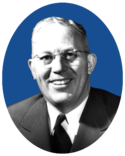1948 Republican National Convention
This article needs additional citations for verification. (June 2016) |
| 1948 presidential election | |
  Nominees Dewey and Warren | |
| Convention | |
|---|---|
| Date(s) | June 21–25, 1948 |
| City | Philadelphia, Pennsylvania |
| Venue | Convention Hall |
| Candidates | |
| Presidential nominee | Thomas E. Dewey of New York |
| Vice-presidential nominee | Earl Warren of California |
The 1948 Republican National Convention was held at the Municipal Auditorium, in Philadelphia, Pennsylvania, from June 21 to 25, 1948.
New York Governor Thomas E. Dewey had paved the way to win the Republican presidential nomination in the primary elections, where he had beaten former Minnesota Governor Harold E. Stassen and World War II General Douglas MacArthur. In Philadelphia he was nominated on the third ballot over opposition from die-hard conservative Ohio Senator Robert A. Taft, the future "minister of peace" Stassen, Michigan Senator Arthur Vandenberg, and California Governor Earl Warren. In all Republican conventions since 1948, the nominee has been selected on the first ballot. Warren was nominated for vice president. The Republican ticket of Dewey and Warren went on to lose the general election to the Democratic ticket of Harry S. Truman and Alben W. Barkley. One of the decisive factors in convening both major party conventions in Philadelphia that year was that Philadelphia was hooked up to the coaxial cable, giving the ability for two of the three then-young television networks, NBC and CBS, to telecast for the first time live gavel-to-gavel coverage along the East Coast. Only a few minutes of kinescope film have survived of these historic, live television broadcasts.[1]
Platform
[edit]The party platform formally adopted at the convention included the following points:
- Reduction of the public debt
- Reduction of the inheritance tax
- Promotion of small business through reduction of governmental intervention and regulation.
- Labor reform
- Elimination of unnecessary federal bureaus, and duplication of functions of necessary governmental agencies.
- Federal aid to states for slum clearance and low-cost housing
- Extension of Social Security benefits
- A federal anti-lynching law
- Federal civil rights legislation. Texas delegate Orville Bullington led a successful protest demanding southern representation on the platform panel considering the civil rights proposals.
- Abolition of the poll tax
- A crackdown on domestic Communism
- Recognition of the state of Israel
- International arms control "on basis of reliable disciplines against bad faith".
- The admissions of Alaska, Hawaii, and Puerto Rico as states to the union.[2]
Candidates before the convention
[edit]- Businessman Riley A. Bender of Illinois
- Speaker of the House Joseph William Martin Jr. of Massachusetts
Balloting
[edit]| Presidential Balloting | |||
|---|---|---|---|
| Candidate | 1st | 2nd | 3rd |
| Dewey | 434 | 515 | 1,094 |
| Taft | 224 | 274 | 0 |
| Stassen | 157 | 149 | 0 |
| Vandenberg | 62 | 62 | 0 |
| Warren | 59 | 57 | 0 |
| Green | 56 | 0 | 0 |
| Driscoll | 35 | 0 | 0 |
| Baldwin | 19 | 19 | 0 |
| Martin | 18 | 10 | 0 |
| Reece | 15 | 1 | 0 |
| MacArthur | 11 | 7 | 0 |
| Dirksen | 1 | 0 | 0 |
| Not Voting | 3 | 0 | 0 |
Presidential Balloting / 4th Day of Convention (June 24, 1948)
-
1st Presidential Ballot
-
2nd Presidential Ballot
-
3rd Presidential Ballot
As of 2024, this was the last Republican Convention to go past the first ballot.
Vice presidential nomination
[edit]Dewey had a long list of potential running mates, including his 1944 running mate, Senator John Bricker of Ohio, Representative Charles Halleck of Indiana, former Governor Harold Stassen of Minnesota, and California Governor Earl Warren.
Dewey chose Warren, who was subsequently nominated by acclaimation.
The Dewey–Warren ticket was the last to consist of two current or former state governors until 2016, when former governors Gary Johnson and Bill Weld ran on the Libertarian Party ticket.
See also
[edit]- History of the United States Republican Party
- List of Republican National Conventions
- 1948 Democratic National Convention
- 1948 United States presidential election
- United States presidential nominating convention
References
[edit]- ^ Simmons, Amy V. (5 August 2016). "The first televised Democratic Convention, 70 years later: An unplanned delegate remembers". Philadelphia Sun. Retrieved 6 August 2016.
- ^ "Republican Party Platform of 1948".
External links
[edit]- Republican Party platform of 1948 at The American Presidency Project
- Dewey acceptance speech at The American Presidency Project
- Video of Dewey acceptance speech for President (via YouTube)
| Preceded by 1944 Chicago, Illinois |
Republican National Conventions | Succeeded by 1952 Chicago, Illinois |
- Republican National Conventions
- 1948 United States presidential election
- Political conventions in Philadelphia
- Old Right (United States)
- 1948 in Pennsylvania
- 1948 conferences
- June 1948 events in the United States
- 1940s political conferences
- 1940s in Philadelphia
- Thomas E. Dewey
- Douglas MacArthur
- Dwight D. Eisenhower
- 1948 in American television










